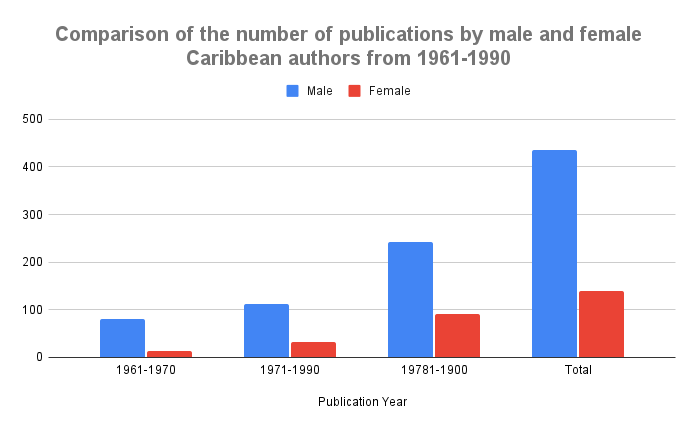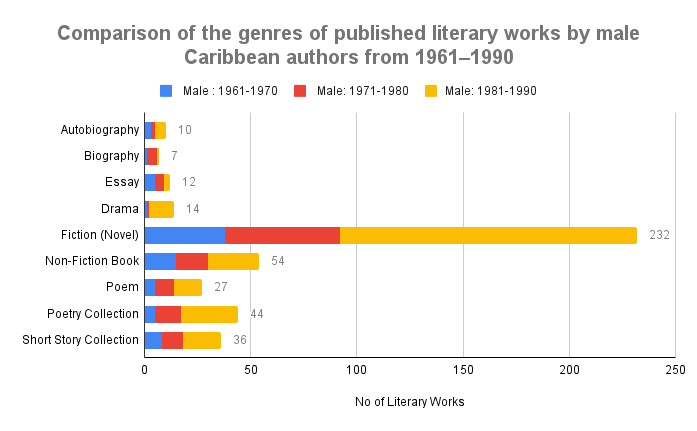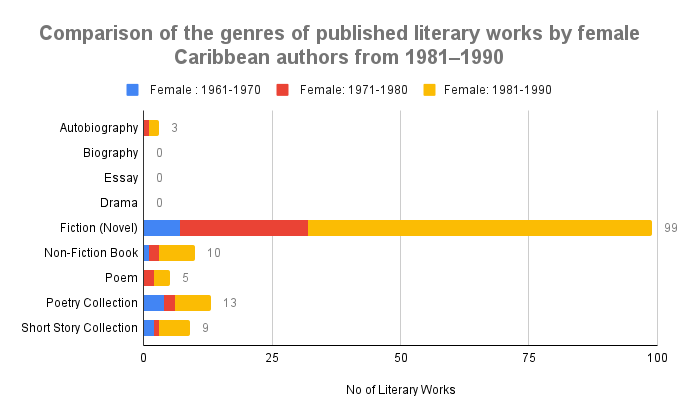Expressive Styles (Genre)
Navigation Links
- Prologue (a)
- Visualizations
a. Comparative Visualizations: Total Amount
b. Comparative Visualizations: Male Authors
c. Comparative Visualizations: Female Authors
d. Comparative Visualizations: Male and Female Authors - Bibliography
Prologue
Genres are categories used to classify literature based on its form, content, and style. In the project, “Writers, Readers, and Scenes,” the expressive styles identified are autobiography (memoir), biography, essay, drama, fiction (novel), fiction (short story), non-fiction, poetry, poetry collection, and short story collection.
- Autobiographies are self-written accounts of one’s life.
- A biography is a literary work that provides a detailed account of another person’s life.
- An essay is a short form of literary composition based on a single subject matter and often expresses the personal opinion of the author.
- Dramas are a type of literature that is meant to be performed in front of an audience.
- A “novel” is a narrative work of prose fiction that tells a story over a considerable length of time.
- A “short story” is a narrative of pure fiction that tells a fully developed story in a short period of time by focusing on one or more self-contained incidents to evoke strong feelings from its readers.
- Non-fiction is a category of literature that was written to provide true and accurate information based on facts and the conclusion of the author’s research or experience, as opposed to the creativity of the author’s imagination.
- Poetry is a genre that consists of writing that follows meter and rhythm for every line written and is organized into schemes such as stanzas.
- A poetry collection is often a compilation of several poems by one poet to be published in a single volume.
- A short story collection is a book of short stories by a single author.
Genres assist the reader in categorizing literature for study or leisure reading. Moreover, it provides a framework for scholars to analyze the importance and impact of texts within a specific category. For an author, the type of genre they choose for work depends on the story they are trying to tell and how they want to shape and portray their characters.
Because genre is all about reader expectations, and if a story doesn’t meet those expectations, it’s finished. Even the most beautiful turn of phrase can’t save it. By Valerie Francis
Many organizations and individuals have recorded the difference in genre based on the gender of authors. Kyle Wholey, a researcher in the Women Writers Project, has observed this based on the organizations’ data set of texts. From this research, she concluded that a greater percentage of females authored novels and poetry, more males authored biographies and dramas, and there was a split ratio for authorship of autobiographies.
Visualizations
Comparative Visualizations: Total Amount

Comparatively, it can be seen that from 1961-1990, there were more male authors publishing literary works than female authors. Moreover, there seems to be an enormous increase in the publication of literary works from 1981–1990, which could be attributed to economic factors such as the creation or financing of local publishing houses that support these authors, cultural factors like the general acceptance of the work of these authors in both local and international markets, and social events like political unrest, independence, or personal experiences that inspired the writing of these authors.
Comparative Visualizations: Male Authors

From comparing the genres published by male Caribbean authors from 1961–1990, it can clearly be seen that fiction (novels) is the most popular genre, followed by non-fiction books and poetry collections. Furthermore, this graphical representation always allows the audience to compare the publication output per decade. As a result, it can be concluded that the relative output of essays by male authors in 1961–1970 was the highest in this observation period. Also, from 1971–1980, a lot more male authors wrote biographies than female authors, and a considerable number of male authors wrote plays and dramas in the years 1981–1990.
Comparative Visualizations: Female Authors

Similarly to the previous chart, from 1961–1990, the most popular genre published by female Caribbean authors from 1961–1990 was fiction (novels), followed by poetry collections and then non-fiction books. However, from this random sample, there were no female-authored literary works for biography, essays, or dramas. Thus, it can be concluded that there is a low publication output of these works. Moreover, from 1961-1970, no female writers wrote autobiographies or poems. Also, female authors produced the most literary works in each genre category from 1981 to 1990.
Comparative Visualizations: Male and Female Authors
Thus, with this data, a chart demonstrating the gender and genre of authors from 1961–1990 can be created and analyzed.

Bibliography
Francis, V. (2020, July 10). The Importance of Genre: What it Means for Your Story. Story Grid. Retrieved March 28, 2022, from https://storygrid.com/importance-of-genre/
Wholey, K. (2018, November 9). Genre and Gender Differences – Women Writers Project. Women Writers Project. Retrieved March 28, 2022, from https://wwp.northeastern.edu/blog/genre-and-gender-differences/
Woodhead Publishing. (n.d.). What is Genre in Literature? Definition, Examples of Literary Genres –. Retrieved March 28, 2022, from http://www.woodheadpublishing.com/literary-devices/genre#:%7E:text=Genres%20are%20important%20because%20they,genres%20from%20poetry%20to%20nonfiction